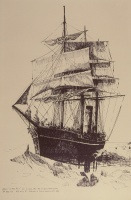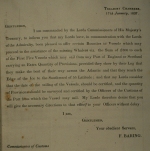Whaling Home | The Arctic | Next
Danger at Sea

The 18th and early 19th century were difficult times for Britain. The country was often at war, and needed a strong navy. The government saw the whaling industry as a way of training men who could serve in the navy. That was why whaling ships had to carry Greenmen (men who had never been to sea before). There was an Impressment Service at this time. It could force any seaman into the navy, unless he carried a certificate of Protection. The enemy could also attack whaling ships, so many were armed. Even so, there was always more danger from the sea and the ice.

In these early days, the ships were sailing vessels. They were usually 3 masted square-riggers, constructed of wood. Even in the summer, the Arctic seas were fraught with danger for a ship relying on the wind for its power. Many were lost after becoming trapped in the ice pack; others escaped its clutches but often at great cost to the lives of their crews. The 1830s were particularly dark times for the whalers as a series of early winters trapped many of the fleet. In 1830, 19 British whaling ships were lost in Melville Bay, between Greenland and Canada. The area became known as the Breaking-up-Yard because of the number of ships sunk there. In 1835, 20 ships became trapped in ice in what became known as the Baffin Bay Fair. 1836 was also a bad year. A document from this time said that the government offered a bounty of £300 for ships that helped search for the missing whalers. Another example of the dangers of whaling was an incident with the Chieftan in 1867.

Accidents also happened closer to home. Conditions in the North Sea could be dangerous and unpredictable. On 13 April 1813, a whaling ship, the Oscar was lost shortly after leaving Aberdeen.